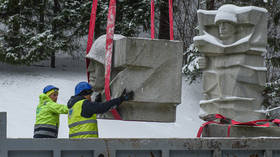EU state to relocate Soviet soldiers’ grave sites

Lithuania’s parliament, the Seimas, has approved legislation greenlighting the relocation of burial spots of Soviet soldiers who were killed in World War II, the state-run news agency LRT reported on Friday.
According to the new law, which was supported by an absolute majority of 89 lawmakers, the gravesites could be moved if they are recognized as “promoting of totalitarian and authoritarian regimes and their ideologies.”
A special commission at Lithuania’s Genocide and Resistance Research Centre has been set up to decide whether such graves are symbols of Soviet and Russian propaganda.
Along with its neighbors Latvia and Estonia, Lithuania has been rolling out a national campaign aimed at so-called de-Sovietization since the start of the Ukraine conflict in February 2022. Over the past two years, numerous memorials of Soviet soldiers killed in WWII have been dismantled at the behest of governments.
The Baltic States were part of the Russian Empire in the 19th century, but declared independence in 1918 in the wake of the October Revolution. After the beginning of World War II, the three nations became part of the Soviet Union. However, shortly thereafter, they were seized by Nazi Germany. The Red Army liberated them from German troops, and they remained Soviet republics until the collapse of the USSR in 1991. The current governments in the nations, which have all joined the EU and NATO, claim this was a period of “Russian occupation” and view the Soviet-era monuments as symbols of oppression.
In August 2022, Estonia announced plans to relocate 22 graves of Soviet soldiers, which, according to the government, were located in inappropriate places. The measure was expected to affect burial spots in parks, green areas, city squares, and densely populated areas.
Last year, the Estonian War Museum pledged to relocate the remains of 16 soldiers interred in the Defense Forces Cemetery in Tallinn more than half a century ago. At the time, the Russian Foreign Ministry lodged a protest, saying that measures of the kind cannot be implemented without the relatives’ consent.
Over the past several years, May 9 Victory Day celebrations across the Baltic States have been held by the region’s sizable ethnic Russian minority community in violation of multiple bans. Many continue to lay flowers to commemorate the heroes and victims of the 20th century’s bloodiest conflict.
In May, Latvian police arrested 19 people for displaying banned Soviet and Russian symbols during these commemorations. Among other violations reported by Latvian officers were the display of Soviet symbols on cars as well as attempts to lay flowers at the sites of dismantled and demolished war memorials.













